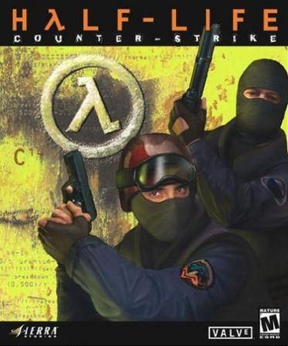
Counter-Strike is a tactical first-person shooter game developed by Valve. It was initially developed and released as a Half-Life modification by Minh "Gooseman" Le and Jess Cliffe in 1999, before Le and Cliffe were hired and the game's intellectual property acquired. Counter-Strike was released by Valve for Microsoft Windows in November 2000, and is the first installment in the Counter-Strike series. Several remakes and ports were released on Xbox, as well as OS X and Linux.
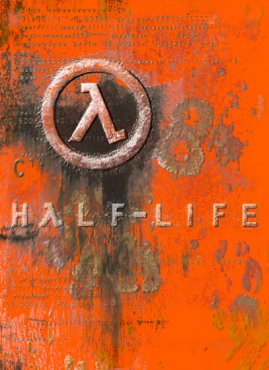
Half-Life is a 1998 first-person shooter game developed by Valve Corporation and published by Sierra Studios for Windows. It was Valve's debut product and the first game in the Half-Life series. The player assumes the role of Gordon Freeman, a scientist who must escape from the Black Mesa Research Facility after it is invaded by aliens following a disastrous scientific experiment. The gameplay consists of combat, exploration and puzzles.

Half-Life: Opposing Force is an expansion pack for the first-person shooter game Half-Life. It was developed by Gearbox Software and published by Sierra On-Line for Windows on November 19, 1999. Opposing Force was the first expansion for Half-Life and was announced in April 1999. Lead designer Randy Pitchford noted that he believed Gearbox was selected to develop Opposing Force because Valve, the creators of Half-Life, wanted to concentrate on their future projects. Over the course of development, Gearbox brought in a variety of talent from other areas of the video games industry to help bolster various aspects of design.

Counter-Strike: Source is a tactical first-person shooter video game developed by Valve and Turtle Rock Studios. Released in October 2004 for Windows, it is a remake of Counter-Strike (2000) using the Source game engine. As in the original, Counter-Strike: Source pits a team of counter-terrorists against a team of terrorists in a series of rounds. Each round is won either by completing an objective or by eliminating all members of the enemy team. The game was initially bundled with all retail and digital copies of Half-Life 2, before being released standalone.

Gearbox Software is an American video game development company based in Frisco, Texas. It was established as a limited liability company in February 1999 by five developers formerly of Rebel Boat Rocker. Randy Pitchford, one of the founders, serves as president and chief executive officer. Gearbox initially created expansions for the Valve game Half-Life, then ported that game and others to console platforms. In 2005, Gearbox launched its first independent set of games, Brothers in Arms, on console and mobile devices. It became their flagship franchise and spun off a comic book series, television documentary, books, and action figures. Their second original game series, Borderlands, commenced in 2009, and by 2015 had sold over 26 million copies. The company also owns the intellectual property of Duke Nukem and Homeworld.

Aliens: Colonial Marines is a 2013 first-person shooter developed by Gearbox Software and published by Sega for PlayStation 3, Windows, and Xbox 360. Based on the Alien universe and set shortly after the events of James Cameron's 1986 film Aliens, the game follows a group of Colonial Marines, a fictional military unit, as they confront the Weyland-Yutani corporation in an effort to rescue survivors from the Sulaco spaceship. The game features a campaign mode that supports both single-player and cooperative gameplay, and a multiplayer mode in which players compete in different scenarios.

Rogue Entertainment was an American computer game developer based in Dallas, Texas, which was active in the late 1990s. It was founded by Rich Fleider, Steve Maines, and Jim Molinets in 1994. Rogue Entertainment's office was in the same building as id Software, all of their games used game engines created by id Software, and two of their games were expansions for id Software's Quake series of games. The company's first game, Strife: Quest for the Sigil, was released as shareware on February 23, 1996, with the retail version later being released on May 31, 1996. Many former Rogue Entertainment employees moved to Nerve Software after Rogue Entertainment shut down.

Turtle Rock Studios is an American video game developer founded in March 2002 by Mike Booth. It was acquired by Valve in 2008, but was re-founded in 2010 as a subsidiary of Slamfire Inc. by Phil Robb and Chris Ashton. Turtle Rock Studios is involved in the creation of original titles as well as the provision of consulting services to the digital entertainment industry.

Half-Life is a series of first-person shooter (FPS) games created by Valve. The games combine shooting combat, puzzles and storytelling.

Counter-Strike Online (CSO) is a tactical first-person shooter video game, targeted towards Asia's gaming market released in 2008. It is based on Counter-Strike and was developed by Nexon with oversight from license-holder Valve. It uses a micropayment model that is managed by a custom version of Steam.
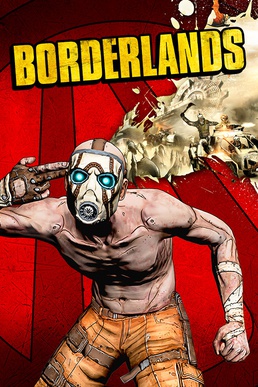
Borderlands is a 2009 action role-playing first-person shooter video game developed by Gearbox Software and published by 2K. It is the first game in the Borderlands series. The game was released worldwide in October 2009 for the PlayStation 3, Xbox 360 and Microsoft Windows, with a Mac OS X version being released on December 3, 2010 by Feral Interactive. The game's story focuses on a group of four "Vault Hunters", who travel to the distant planet of Pandora to search for the "Vault", which is rumored to contain advanced alien technology and other priceless riches. The hunters piece together clues to find the Vault while battling the savage wildlife of Pandora, local bandits that populate the planet, and ultimately banding together to prevent the Atlas Corporation and its privately funded paramilitary forces from reaching the Vault first.
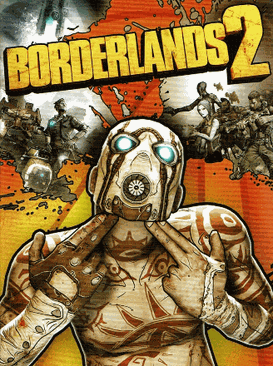
Borderlands 2 is a 2012 action role-playing first-person shooter video game developed by Gearbox Software and published by 2K. Taking place five years following the events of Borderlands (2009), the game is again set on the planet of Pandora. The story follows a new group of Vault Hunters who must ally with the Crimson Raiders, a resistance group made up of civilian survivors and guerrilla fighters, to defeat the tyrannical Handsome Jack before he can unlock the power of a new Vault. The game features the ability to explore the in-game world and complete main missions and optional side quests, either in offline splitscreen, single-player or online cooperative gameplay. Like its predecessor, the game features a procedurally generated loot system which is capable of generating numerous combinations of weapons and other gear.

Counter-Strike: Global Offensive (CS:GO) is a 2012 multiplayer tactical first-person shooter developed by Valve and Hidden Path Entertainment. It is the fourth game in the Counter-Strike series. Developed for over two years, Global Offensive was released for OS X, PlayStation 3, Windows, and Xbox 360 in August 2012, and for Linux in 2014.
Counter-Strike (CS) is a series of multiplayer tactical first-person shooter video games in which teams of terrorists battle to perpetrate an act of terror while counter-terrorists try to prevent it. The series began on Windows in 1999 with the release of the first game, Counter-Strike. It was initially released as a modification ("mod") for Half-Life that was designed by Minh "Gooseman" Le and Jess "Cliffe" Cliffe before the rights to the mod's intellectual property were acquired by Valve, the developers of Half-Life, who then turned Counter-Strike into a retail product released in 2000.
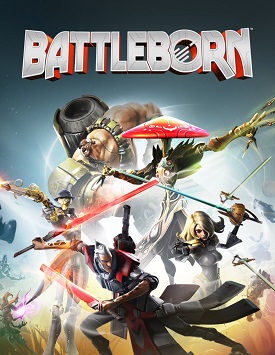
Battleborn was a free-to-play first-person shooter video game developed by Gearbox Software and published by 2K for PlayStation 4, Windows, and Xbox One. The game was released worldwide on May 3, 2016.
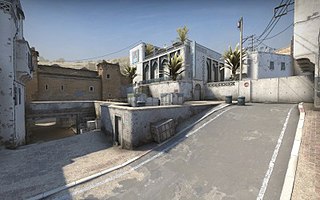
"Dust II", also known by its filename de_dust2, is a video game map featured in the first-person shooter series Counter-Strike. Dust II is the successor to "Dust", another Counter-Strike map, and was developed by David Johnston before the official release of the original Counter-Strike game. It was designed with the aims of simplicity and balance, based on its symmetrical design and two points, over which the two teams must fight for control.
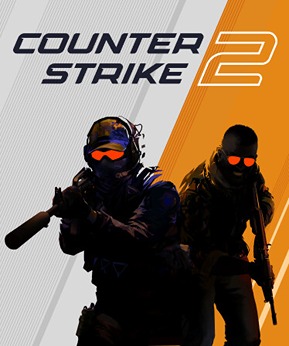
Counter-Strike 2 is a 2023 multiplayer tactical first-person shooter game developed and published by Valve. It is the fifth main installment of the Counter-Strike series. Developed as an updated version of the previous main entry, Counter-Strike: Global Offensive (2012), it was announced on March 22, 2023, and was released on September 27, 2023, for Windows and Linux, replacing Global Offensive on Steam.
















